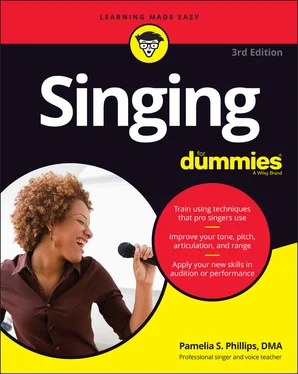If you have no singing experience, you may want to start with Chapter 1and work your way through the chapters in order. However, this book is designed to allow you to jump in anywhere you want and start swimming through information that’s completely understandable. If you have some singing experience, choose whatever chapter appeals to you. You may have to refer to other chapters occasionally if you missed a definition, but otherwise, you’re free to roam the chapters at your own pace and in any order. As you work through the exercises in this book, you want to have the basic technical skills of breathing (see Chapter 4) and tone (see Chapters 5and 6) readily available. If you find yourself struggling, you may want to go straight to Chapter 3to make sure that you have proper singing posture.
Part 1
IN THIS PART …
Find out about different voice types and figure out which category fits your voice.
Understand that great posture can get your body lined up and ready to sing your best.
Discover the importance of air moving in and out of your body to keep the glorious sounds coming out.
Focus on tone, which allows you to improve on the sounds you’re already making or tweak your tone a little if your engine knocks rather than hums.
Chapter 1
IN THIS CHAPTER
 Thinking about your voice type
Thinking about your voice type
 Starting with the basics: Posture, breath, and tone
Starting with the basics: Posture, breath, and tone
 Getting familiar with the different parts of your voice
Getting familiar with the different parts of your voice
 Starting to apply your vocal technique
Starting to apply your vocal technique
So you’re curious about singing. Whatever musical background and experience you have or don’t have, this book has something to offer you. The book contains great exercises and online tracks that allow you to hear the exercise and sing along. If you’re a beginner, welcome aboard. You can find out all kinds of cool info about singing in this book. This chapter provides an overview of all the great stuff you can encounter in the book.
Singing is one of the coolest means of expression out there. Singing well is about knowing how to work the parts that create the sound for singing. The chapters that you encounter in the book outline what you need to know in just the right sequence. You don’t have to read them in the order written to get what you need. Some of the later chapters may be a little difficult if you don’t have any singing experience. The only way to know is to jump right in and start reading on whatever topic interests you.
What You Want to Know Right from the Beginning
Before you choose the date for your first big concert or recital, you want to find out about singing. The first part of this book provides you with the big picture.
Determining your voice type
Singers usually are eager to determine their voice type because they want a category to belong to. You may have heard of the categories of singers:
Soprano: Higher female voice
Mezzo: Lower female voice
Tenor: Higher male voice
Bass: Lower male voice
If you aren’t sure which one applies to your voice, explore Chapter 2. You can find explanations of what makes a soprano differ from a mezzo, or a tenor differ from a bass. You don’t have to figure out your voice type today, but you can explore the chapter so you know what to listen for as you sing.
Locating the notes on the staff
Voice types are probably easier to figure out if you know where to find the notes on a musical staff. (See Figure 1-1 in this chapter.) The names of the notes are A, B, C, D, E, F, and G. Those notes repeat across the piano.
The treble clef spaces correspond to the notes F, A, C, and E. Beginning on the bottom of the staff and going up, the notes spell face . You can use sentences to remember the other notes. Again, starting on the bottom line and moving up, the notes on the lines of the staff are E, G, B, D, and F, letters that begin the words of the sentence Every good boy does fine.
For the bass clef, the spaces are A, C, E, and G, the letters that begin the sentences All cows eat grass or All cars eat gas. The lines in the bass clef are G, B, D, F, and A, which correspond to Good boys do fine always. If you prefer animals, then use Great big dogs fight animals.
If I say that a singer’s range is Middle C to High C, I have to use ledger lines to notate those two notes because they’re not within the five-line staff. Ledger lines are extra lines added above or below the staff for notes that are higher or lower than the notes on the staff. When you find Middle C in Figure 1-1, you can see the extra line added below the staff. The easiest way to find Middle C on the piano is to look at the brand name printed on or above the lid covering the keys. If you find that brand name, the C right in the middle of that name, or just to the left, is usually Middle C.

© John Wiley & Sons, Inc.
FIGURE 1-1:Locating notes on the staff.
 Middle C is called Middle C because it’s in the middle of the keyboard that contains 88 keys. Middle C is also called C4, because it’s the fourth C on the keyboard. If Middle C is C4, then the next C above is C5, and so on. C is the note just to the left of the pair of black keys. The distance between the two Cs is called an octave. If you start counting at the first C and count eight white notes up, you find another C . That means the E just above Middle C (C4) is E4. Easy enough, but not every person you encounter knows this system, so I stick to what works: Middle C.
Middle C is called Middle C because it’s in the middle of the keyboard that contains 88 keys. Middle C is also called C4, because it’s the fourth C on the keyboard. If Middle C is C4, then the next C above is C5, and so on. C is the note just to the left of the pair of black keys. The distance between the two Cs is called an octave. If you start counting at the first C and count eight white notes up, you find another C . That means the E just above Middle C (C4) is E4. Easy enough, but not every person you encounter knows this system, so I stick to what works: Middle C.
You also encounter the words flat and sharp in this book. A flat lowers a pitch a half step and a sharp raises the pitch a half step. F-sharp is the black key on the piano between F and G. The same black key between F and G can be called G-flat.
Considering posture, breath, and tone
First, you want to get yourself aligned — that is, line up all your body parts to get ready to sing — and then explore your breathing. Breathing while singing is different from breathing normally, because you have to take in more air and use more air over a longer period of time. When you get the air flowing, you can explore the tone of your voice.
Correcting posture for a better sound: Posture is important in singing well. If all the parts for singing are lined up correctly, you stand a really good chance of getting wonderful sounds to come flying out of your body. Knowing how to stand isn’t rocket science, but it may take a little adjustment on your part. If you aren’t used to standing tall all the time, you may feel a bit awkward at first. Chapter 3explores posture for singing.
Knowing the keys to proper breathing: The big key to great singing is knowing how to use your breath to make the sounds. You may not know how to get much breath in your body and then make it last throughout a long phrase. If you check out Chapter 4, you can find all kinds of exercises and explanations on how to work on your breath so you can sing those long phrases in your favorite song.
Читать дальше

 Thinking about your voice type
Thinking about your voice type
 Middle C is called Middle C because it’s in the middle of the keyboard that contains 88 keys. Middle C is also called C4, because it’s the fourth C on the keyboard. If Middle C is C4, then the next C above is C5, and so on. C is the note just to the left of the pair of black keys. The distance between the two Cs is called an octave. If you start counting at the first C and count eight white notes up, you find another C . That means the E just above Middle C (C4) is E4. Easy enough, but not every person you encounter knows this system, so I stick to what works: Middle C.
Middle C is called Middle C because it’s in the middle of the keyboard that contains 88 keys. Middle C is also called C4, because it’s the fourth C on the keyboard. If Middle C is C4, then the next C above is C5, and so on. C is the note just to the left of the pair of black keys. The distance between the two Cs is called an octave. If you start counting at the first C and count eight white notes up, you find another C . That means the E just above Middle C (C4) is E4. Easy enough, but not every person you encounter knows this system, so I stick to what works: Middle C.










